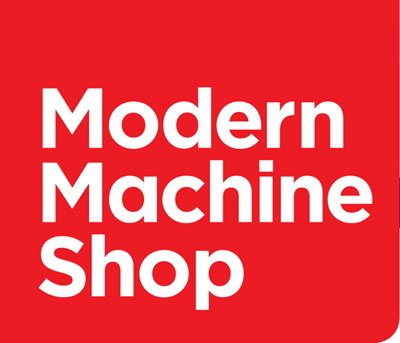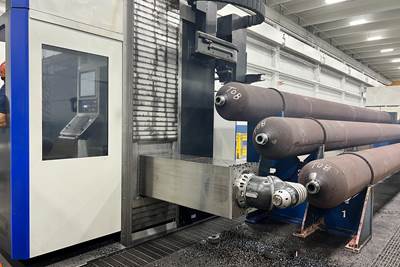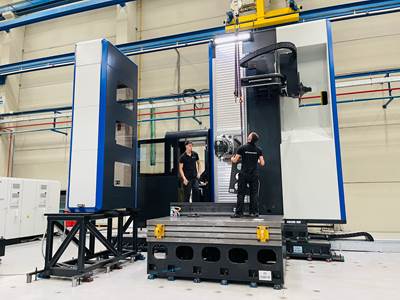Share






For Soraluce, the machine head, which contains the components that enable the machine tool to complete machining operations, is the most important part of its machine tools. This component is the only component manufactured on site at its headquarters in Bergara, Spain. Photos provided by Soraluce.
“The head is the heart of the machine.” I heard this quote several times during a tour of Soraluce’s headquarters in Bergara, in the Basque region of Spain. The plant mainly houses assembly of floor-type and bridge-type multitasking machines, with only one crucial component being manufactured in-house — the machine heads.
The machine head contains the components that enable the machine tool to complete machining operations. Depending on the type of head, it might contain the motor, spindle, toolholder and cutting tool. “If you don't have a good spindle or high-quality head, you might as well not have a good machine,” says Doug Schulte, senior product manager at Select Machining Technologies, Soraluce’s exclusive US importer since 2019.
Being that the head is such a critical part of the machine, it makes sense that Soraluce machines the components and assembles them in house. “Because it's the heart, we consider it strategic for our business,” explains Oier Elguezabal, vice president of global sales at Soraluce. “The head department at Soraluce is a manufacturing company inside the company,” Schulte explains. “It has its own management, its own procurement, its own design engineering and assembly.” Production of other machine tool components takes place at other facilities owned by Danotbatgroup, a Spanish manufacturing co-op of which Soraluce is a member. (We stopped by one such shop the next day, Goimek, where the castings for Soraluce’s large-format machine tools are machined.)
Back at the Bergara factory, Soraluce was wrapping up an expansion of its head production area. Plant Seven, which will open in late 2024, will house the company’s new head production and assembly area. This will enable Soraluce to increase production of machine heads, as demand for machines and machine heads increases.

Many of Soraluce’s machine tools have the option of a head-changing system. While not in use, machine heads are stored in fully enclosed pickup stations off to the side of the machine table.
Changeable Heads
All but Soraluce’s smallest machine tools have the option of a head changing system. According to Elguezabal, this is a popular choice for users. He says the company manufactures between 100 and 120 machines, and between 250 and 260 heads each year for an average of 2.6 heads per machine. The maximum number of changeable heads a machine can have is determined by the machine’s height — a good rule of thumb is one machine head per meter of z-axis stroke; but if an application requires more, the company can incorporate additional pickup stations. When not in use, the heads are stored in a fully enclosed pickup station off to the side of the machine table.
The most popular heads are the indexing heads, which come in two main types: universal and orthogonal. Universal indexing heads have one joint against the face of the ram, which can be vertical or horizontal, and then another joint at a 45-degree angle. Orthogonal indexing heads have a joint against the face of the ram, and a second joint at a 90-degree angle. This enables the head to turn back and machine at a negative 45-degree angle, towards the machine tool’s column. Indexing heads can have indexing capabilities from 2.5 degrees to 0.001 degree.

Soraluce offers a number of machine heads, including universal and orthogonal indexing heads, five-axis contouring heads, multitasking heads, angular heads, fixed horizontal boring heads and other custom options. Interchangeable machine heads enable the machine tool to perform more operations, reducing the number of setups required.
Other head options for Soraluce machines include five-axis contouring heads, multitasking heads, angular heads and fixed horizontal boring heads. The company also designs custom heads for applications with specific angles or tight tolerances. Another option is the patented modular quill system, which enables users to switch between a quill and standard machine heads.
Elguezabal says demand for multiple machine heads per machine is increasing, particularly as Soraluce releases heads with new capabilities, such as the five-axis contouring head. Because Soraluce integrates the C-axis into the machine head instead of the ram, like on other machine tools, the company can offer a five-axis changeable head. “Full five-axis contouring is becoming much more popular,” Schulte adds. “We're quoting more and more and more five-axis contouring heads.” According to Elguezabal, users often pair the five-axis head with other heads, such as an indexing head. “They have the strong indexing head for roughing, and they have the five-axis contouring head for finishing,” he explains.
At the same time, users may need fewer machine heads as Soraluce releases heads that can perform multiple machining operations. Elguezabal cites multitasking heads as an example. “The same head can mill and can turn,” he explains. “A few years ago, you needed to have two heads: one for milling and one for turning.”
Ultimately, the changeable head concept can help shops reduce setups by enabling the machine tool to perform more operations. “The head is what gives a lot of flexibility to the machines,” Elguezabal explains. “These machines are, generally speaking, general purpose machines. They are not dedicated to one application.”
Schulte pointed out a machine on the factory floor that illustrated this benefit perfectly — a FLP floor-type milling and boring machine with an H117 five-axis contouring head and a fixed horizontal head that was headed to Lawrence Livermore National Laboratory in Livermore, California. “They wanted five axes, but also wanted a boring mill,” Schulte says. “So, the five-axis head with the fixed horizontal boring head gives them that capability.” Lawrence Livermore is a prototype lab, so it makes a wide variety of large one-off parts. “There are many times that they'll have a part fixtured on the table and it'll be hanging 20 feet out into the aisle because they're just machining the end,” he adds. These parts used to require lots of repositioning. “Now, with the universal five-axis head, they'll be able to do it all while it sits in one place.”

Not only does Soraluce build machine heads at its headquarters, it also repairs and refurbishes them. If a machine head is out for refurbishment, users can continue running their machines with additional and spare heads.
Testing and Repair
After the heads are assembled at Soraluce’s headquarters, they’re tested on site. “Before it leaves the assembly room, whether it's a new head or a refurbished head, it has been completely run and tested and it’s ready to go on your machine and go to work,” Schulte says. “We're checking for indexing, heat, temperature and pressures inside the head.” Soraluce tests its machine heads in conditions that mimic real applications as closely as possible, using test benches that can tilt 90 degrees for vertical heads. Plant Seven will contain more benches to test heads with full five-axis contouring capabilities. Soraluce also tests all aspects of heads with through-coolant capabilities with high-pressure coolant running.
Plant Seven will also include a new area for head refurbishment. “When you have over 3,500 machines in the field, over time, you're going to need to rebuild heads,” Schulte says. Users can send damaged head back to Soraluce, which disassembles them and creates a report outlining what needs to be replaced and repaired. Then the company fixes the head and sends it back to the customer. In addition to Soraluce’s plant in Spain, its U.S. partner Select Machining Technologies is establishing a new head repair facility in Huntsville, Alabama.
While a head is off for refurbishment, users with changeable heads can continue machining with the other heads they have, or Soraluce can send a spare head for customers to use while the original head is being refurbished. This is a major advantage of the changeable head system — shops no longer need to deal with unplanned downtime when a machine head is damaged.
The same concept applies to Soraluce’s modular quills as well. As we made our way through the refurbishment area, Schulte spotted a modular quill that was in the process of being repaired. “If that was a traditional quill, and there was some damage to that quill, that machine would be down,” he explains. “Since they've got a modular quill on that machine, the quill can come back here for a repair while they continue to run the machine with one of any number of heads.”

IDEKO is Soraluce’s manufacturing research and development center, located in the nearby town of Elgoibar. It has been instrumental in developing technologies such as Ram Balance and Accura Heads, which make machines with changeable heads more accurate and precise.
Ahead of the Curve
The Soraluce Summit also included a stop at IDEKO, a manufacturing research and development center that’s part of the Basque Research and Technology Alliance. IDEKO is part of Danobatgroup and serves as Soraluce’s technology center. Many technologies that began as research projects at IDEKO are developed and commercialized by Soraluce. IDEKO and Soraluce have developed such technologies as Dynamic Workpiece Stabilization and Dynamic Active Stabilizer.
The center’s research also provided the basis for Soraluce’s Ram Balance feature. This is useful for machines with interchangeable heads, because each machine head has a different weight. The change in weight can affect the straightness of the machine’s ram — the heavier the head, the more the end of the ram is weighed down and “droops.” This effect can trickle down, affecting the quality of the workpiece. Ram Balance automatically adds pressure to the end of the ram as it moves away from the machine column, keeping the ram straight and preventing it from drooping. Its NC servocontrol and a compensation table are said to keep a 1.9-meter ram to within 40 microns of droop.
IDEKO was also instrumental in developing Soraluce’s Accura Heads technology. This is a calibration device that enables users to recalculate the offsets in the kinematic model of the head, helping the machine maintain precision as it runs and changes heads. Other calibration systems use probes that move, while the Accura Heads probe stays fixed and therefore consistent as the head changes position. “Accura Heads will inspect 64 common positions of the head. And it'll verify the tool center point of all those 64 positions,” Schulte explains. “And then it will update the kinematic model and compensate the settings in the CNC for those 64 positions to make sure that you have your tool center point.”
Users can also set compensations for a given head position. “Let's say you've got an angle that's not one of those 64 positions, and it's a critical angle for your application. Right before you do that machining process, you'd run a probing routine to verify that angle and accuracy. And then we can compensate for that single position right before we run that tool so we can verify 100% that the tool’s center points are accurate at that moment,” Schulte adds. Accura Heads is quoted as standard with stepless heads. “When you're looking at a machine that's over a million dollars, Accura Heads is well worth that investment,” Schulte notes.
Related Content
How to Successfully Adopt Five-Axis Machining
While there are many changes to adopt when moving to five-axis, they all compliment the overall goal of better parts through less operations.
Read MoreBallbar Testing Benefits Low-Volume Manufacturing
Thanks to ballbar testing with a Renishaw QC20-W, the Autodesk Technology Centers now have more confidence in their machine tools.
Read MoreHow to Mitigate Chatter to Boost Machining Rates
There are usually better solutions to chatter than just reducing the feed rate. Through vibration analysis, the chatter problem can be solved, enabling much higher metal removal rates, better quality and longer tool life.
Read More5 Tips for Running a Profitable Aerospace Shop
Aerospace machining is a demanding and competitive sector of manufacturing, but this shop demonstrates five ways to find aerospace success.
Read MoreRead Next
How I Made It: Doug Schulte, Select Machining Technologies
Doug Schulte was introduced to machining as a young child, often visiting his father at the LeBlond Machine Tool company where he worked in Cincinnati. Here, Schulte — who ended up dedicating his entire career to the industry — shares some of the key insights he’s discovered along the way.
Read MoreLarge-Format Machining Simplifies Tube Manufacturing
Downtime is the enemy of efficient manufacturing — a problem FIBA Technologies has addressed through purchasing a Soraluce FLP 14000.
Read MoreControlling Extreme Cutting Conditions in Large-Part Machining
Newly patented technologies for controlling chatter and vibration during milling, turning and boring operations promise to drastically reduce production time and increase machining performance.
Read More































.jpg;maxWidth=970;quality=90)